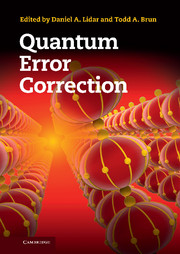Book contents
- Frontmatter
- Contents
- List of contributors
- Prologue
- Preface and guide to the reader
- Acknowledgements
- Part I Background
- 1 Introduction to decoherence and noise in open quantum systems
- 2 Introduction to quantum error correction
- 3 Introduction to decoherence-free subspaces and noiseless subsystems
- 4 Introduction to quantum dynamical decoupling
- 5 Introduction to quantum fault tolerance
- Part II Generalized approaches to quantum error correction
- Part III Advanced quantum codes
- Part IV Advanced dynamical decoupling
- Part V Alternative quantum computation approaches
- Part VI Topological methods
- Part VII Applications and implementations
- Part VIII Critical evaluation of fault tolerance
- References
- Index
1 - Introduction to decoherence and noise in open quantum systems
from Part I - Background
Published online by Cambridge University Press: 05 September 2013
- Frontmatter
- Contents
- List of contributors
- Prologue
- Preface and guide to the reader
- Acknowledgements
- Part I Background
- 1 Introduction to decoherence and noise in open quantum systems
- 2 Introduction to quantum error correction
- 3 Introduction to decoherence-free subspaces and noiseless subsystems
- 4 Introduction to quantum dynamical decoupling
- 5 Introduction to quantum fault tolerance
- Part II Generalized approaches to quantum error correction
- Part III Advanced quantum codes
- Part IV Advanced dynamical decoupling
- Part V Alternative quantum computation approaches
- Part VI Topological methods
- Part VII Applications and implementations
- Part VIII Critical evaluation of fault tolerance
- References
- Index
Summary
Introduction
This chapter gives the physical and mathematical basis of decoherence in quantum systems, with particular emphasis on its importance in quantum information theory and quantum computation. We assume that the reader is already familiar with the basics of quantum mechanics, such as wave functions, the Schrödinger equation, and Hilbert spaces, which are covered in standard textbooks. Nevertheless, all basic concepts will be at least briefly defined and described. A working knowledge of graduate-level linear algebra and calculus is also assumed.
In quantum information processing, the term decoherence is often used loosely to describe any kind of noise that can affect a quantum system. This can include sources of noise that seem, qualitatively, to be quite different from each other. These noise sources include:
(i) Random driving forces from the environment (e.g., Brownian motion).
(ii) Interactions that produce entanglement between the system and the environment.
(iii) Statistical imprecision in the experimental controls on the system (e.g., timing errors, frequency fluctuations, etc.).
Remarkably, all of these sources of noise can be described by an almost identical mathematical framework, in which pure quantum states can evolve into mixed quantum states, and the quantum effects necessary for information processing – interference, entanglement, and reversible evolution – are disrupted.
The chapter begins by examining a highly schematic model of decoherence, involving systems of qubits, but uses this model to present the mathematical formalism used in describing more realistic systems as well.
- Type
- Chapter
- Information
- Quantum Error Correction , pp. 3 - 45Publisher: Cambridge University PressPrint publication year: 2013
- 2
- Cited by



